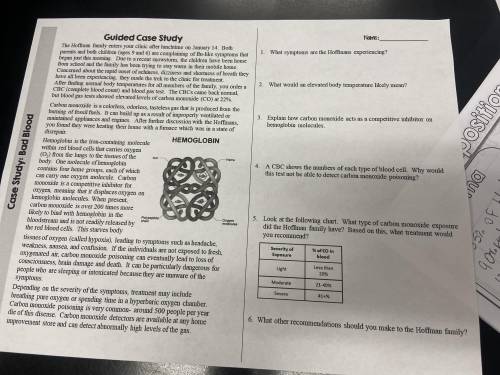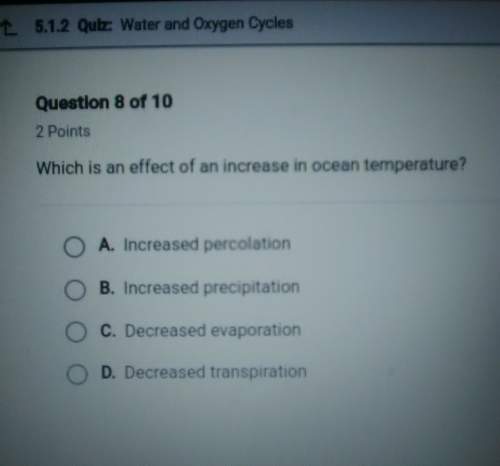
Biology, 23.02.2021 23:40 kevinmoniz90
1. What symptoms are the Hoffman’s experiencing?
2. What would an elevated temperature likely mean?
3. Explain how carbon monoxide acts as a competitive inhibitor on hemoglobin molecules?
4. A CBC shows the numbers of each type of blood cell. Why would this test not be able to detect carbon monoxide poisoning?
5. Look at the following chart (see image attached) what type of carbon monoxide exposure did the Hoffman family have? Based on this, what treatment would you recommend?
6. What recommendations should you make to the Hoffman family?


Answers: 2
Another question on Biology

Biology, 22.06.2019 04:10
How are the reproductive cycles of a fungus and a pteridophyte similar? a)both organisms form fruiting bodies that produce diploid seeds. b)both organisms produce haploid spores and exhibit diploid and haploid stages. c)both organisms reproduce sexually when two haploid hyphae fuse. d)both organisms exhibit a diploid stage and are only able to reproduce asexually.
Answers: 1

Biology, 22.06.2019 06:30
Zoo geographic regions are characterized by the presence of specific groups of animals these regions are determined by the taxonomic or phylogenetic relationships of animals. the map shows the zoogeographic regions proposed by the naturalist alfred russel wallace in 1876. the similarities of organisms in which two areas numbered above provide the best evidence for common ancestry between the organisms in both locations ?
Answers: 3

Biology, 22.06.2019 07:00
Explain how sequences of amino acids in proteins can be used to reveal relationships among organisms.
Answers: 2

Biology, 22.06.2019 09:10
Refer to this portion of a dichotomous key for fish identification to answer the question. 1. (a) has a single dorsal fin ® 5 (b) has a double dorsal fin ® 2 2. (a) one fin is spiny, the other is smooth ® 3 (b) one fin is not spiny or smooth ® 4 5. (a) has small fin on back near tail ® 6 (b) has no fin on back near tail ® 7 6. (a) has barbs near the mouth ® catfish (b) does not have barbs near the mouth ® 10 7. (a) tail is asymmetrical ® 8 (b) tail is symmetrical ® 9 10. (a) scales are small ® trout (b) scales are large ® whitefish what is the next step to complete to identify a fish that has a single dorsal fin, no fin on the back near the tail, and no barbs near the mouth? step 2 step 5 step 7 step 10
Answers: 2
You know the right answer?
1. What symptoms are the Hoffman’s experiencing?
2. What would an elevated temperature likely mean?...
Questions

Mathematics, 09.11.2020 05:30

Mathematics, 09.11.2020 05:30

Mathematics, 09.11.2020 05:30

English, 09.11.2020 05:30

Mathematics, 09.11.2020 05:30


Physics, 09.11.2020 05:30



Biology, 09.11.2020 05:30


Mathematics, 09.11.2020 05:30

Mathematics, 09.11.2020 05:30

English, 09.11.2020 05:30


Mathematics, 09.11.2020 05:30



Mathematics, 09.11.2020 05:30

Biology, 09.11.2020 05:30




